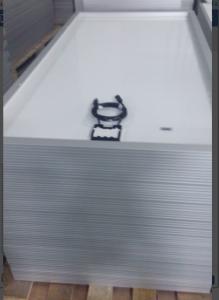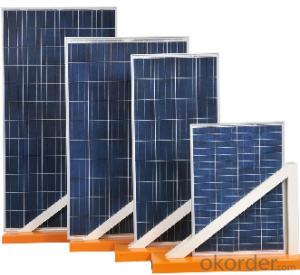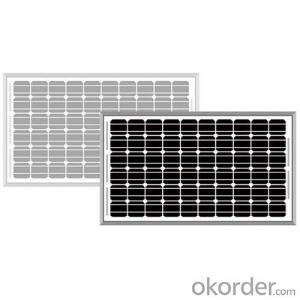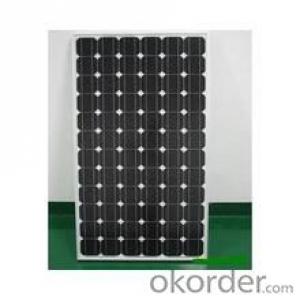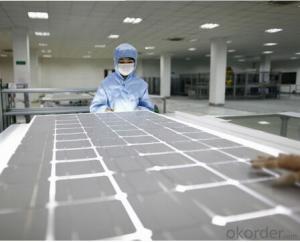2*100w Mono Crystalline Solar Panels for Appliances
- Loading Port:
- Shanghai
- Payment Terms:
- TT OR LC
- Min Order Qty:
- 1000 watt
- Supply Capability:
- 1000000 watt/month
OKorder Service Pledge
OKorder Financial Service
You Might Also Like
Specification
Product Description

Features:
Can charge any 12V battery with 5m cable alligator clip
Combined by 2pcs individual high-efficient monocrystalline silicon solar panels;
Stainless steel telescopic legs ( can freely rotate 180 degrees)
High-strength low-iron toughened glass
Anodized aluminum frame
Light weight, easy to carry outside
With a charge controller with LED charge status display and electronic circuit protection
Long life time: >=25 years, small attenuation (Resistance to humidity and salt fog corrosion)
Stability and high efficiency photoelectric conversion, the average conversion rate is 17%
± 3% performance tolerance
Accessories: Controller(10A), cable (5m), alligator clip, supporting leg, carry bag, junction box, corner protection, lock and handle
Packaging: Nonwoven or canvas bag with outer carton, bulk order with pallet
Suitable for home/caravans/camper (powering lap-top, phones, lights, TV, radios, small pumps and other small household electrical appliances)
When you go camping/hiking:
For laptop! No problem.
For iphone/ smart phones! No problem.
For PSP, for other players! No problem.
One portable solar panel charger solves all your charging problems!
Attention:
In the case of no load, do not connect the positive and negative.
Our advantages:
We have patents for the essential parts of the products----controller and inverter
All our products are approved by CE and ISO9001
We can do OEM and ODM, and we have our own talented R&D teams
All our products are easy to be used and convenient in maintanence
Strong technical team is ready to work for you.
Specifications
12v/18v 120W Folding Solar Panel A) collapsible
B) waterproof and easy to carry
C)Suitable for outdoor travel, camping
Fast delivery+high quality: Folding solar panel full waterproof---suitable for camping, trekker, 4WD, boating etc!
Foldable solar panel 120W folding solar panel for charge DC 12V solar system & 12V battery
Electrical Characteristics | |
Cells size (mm): | 156*103.7 |
Cells per module: | 36pcs |
Module size (mm): | 670*1005*35mm |
Power tolerance: | +/-3% |
Nominal peak power(WP): | 2*100w |
Nominal voltage(V): | 18 |
Nominal current (A): | 11.11 |
NOCT: | 45+/-2degree |
Voltage temperature coefficient: | -0.33%/degree |
Current temperature coefficient: | +0.05%/degree |
Power temperature coefficient: | -0.23%/degree |
Open circuit voltage (Voc): | 21.6 |
Short cirsuit current(Isc): | 12.00 |
Conversion efficiency: | 17.26% |
Operating temperature: | -40 to+85degree |
Max system voltage: | 1000V DC |
Surface Maximum Load Capacity | 60m/s(200kg/sq. m) |
- Q: Solar panels which is the one produces the power...I wanna the complete description about it...
- If you're expecting to use them for anything other than a science fair project, don't bother. In order to produce any significant amount of power, solar panels have to be made of complex materials and coated with special coatings. If you want to power anything with them you'll need an inverter. Solar is not a DIY project (no matter how much those scam kits claim). If you're serious about solar, call your local solar installer and talk to them about it.
- Q: So, I've seen cheap solar panel kits for sale from Harbor Freight, and regardless of whether or not I were to buy a set from them or someone else, I was wondering what the process of implementing a small-scale solar system into your household electrical system would be.I've read articles that started out too in-depth or were speaking of systems on a much larger scale.Can it be as easy as buying the panels and inverter, and plugging it into a socket, or is there more to it?Some of the articles I was reading had mentioned having to contract with your electrical supplier, having to have an electrician tie it all in in some special/ necessary way, using a battery pack (would this be necessary for a tied-in system?), or using the system to only power single items, like a water heater, or plugging items into a connected battery-pack, all of which I'm not sure is necessary or needed for what my goals/ means are/ would be.
- You can't directly connect solar panel into household electrical system,you need to convert DC power to AC power more over it will cost more amount...
- Q: I have a solar panel i got for free and I don't know what to do with it. Its kinda big at about 20x 0and it puts our 2 VOC / .23 ISC. I don't know of anything that I could use it for. Its too big to say charge a phone or ipod....any suggestions??
- 2 volts rate at .23 ampere. It can be used to charge car battery. Put a 5 ohms rated 0 watts resistor in series between panel and 2.6 volts car battery to lower its voltage.
- Q: Can solar panels be installed on a prison or correctional facility?
- Yes, solar panels can be installed on a prison or correctional facility.
- Q: Hi, wanting to set up the most basic solar panel system for a cabin in the woods that has enough power to recharge four 2V car batteries during the daytime (i am assuming; we want to run a mini fridge maybe a stove and a few lights at night off the batteries and be able to run it all just off solar during the day) It also needs to be able to power some simple tools during the day... Experience would be absolutely amazing since alot of the info on solar paneling is either really dumbed down, or ridiculously confusing.As of right now I am looking at a 3 panel (45watt in all) solar kit that needs a 300w inverter.... is this sufficient for my power needs? I am just a little perplexed, thanks so much!
- That okorder /... , but expect to pay several thousand dollars for something that actually works. If you just want to use the place for intermittent getaways, a generator may be sufficient, and you can skip the solar panels. If you intend to live in the place, then consider getting a system that is at least 500-000 watts of panels, and a 000 amp-hour or more battery bank.
- Q: Me and my wife just saw an ad on TV about going solar and saw the money we can save every month... any here have solar panels? How much do you save every month on energy bill? Is it true that your energy meter will spin backwards? lol
- Yes, it can save money, but really depends on your individual situation. There are three main factors - how much sun you get, how much electricity you use, and how much electricity costs locally. We have solar, and the meter does spin backwards. Actually, it's a digital meter, so it counts down instead of up. The system covers essentially all our electrical usage over the year, and our electric bill is about $5 a month, because of minimum charges by the electric company. That shouldn't be used as a comparison to your situation, though, since every house is different.
- Q: Hi everyone, I am a novice in solar energy system. I want to know if I am on the right track. Recently I bought a 30 W solar panel, 5 Amp controller, and a 22 Ah battery, how many watts and what kind of INVERTER do I need? I did an research some said 50 W and some said 300 W. And am I right on the 5 amp controller and 22 Ah battery to provide larger output of electric, or the higher the # the greater output for 30 W solar panel?Really appreciate for anyone who help!!!
- must be one of the place who's place have sun
- Q: I'm going to this camp and the instructors asked us to be prepared tomorrow to build a sun tracker for a solar panel. Does any one have any ideas, tips, or advice?
- Since the sun moves in the sky on a very predicatable course you don't need a closed loop control system to track it. All you need is a clock-drive motor and the proper gearing for your latitude. The clock drive motor will move at a constant rotational velocity based on time, and when it is geared down properly the angle of the shaft will follow the sun. Make sure the clock motor is powerful enough to move the solar panel, etc. That's a start, anyway. .
- Q: Properties of solar panel?I know this is too general,but i am to write a report on the materials used to make solar panels,and i am to include the physical, mechanical ,and chemical properties of the materials.It's just too general,such that i am lost.There are so many types of solar panels.So i hope some experts on this subject can give me a general guide lines ,maybe the tensile strength ?as much as you can please.
- Properties Of Solar Energy
- Q: i want to how i make solar panels
- DIY okorder
Send your message to us
2*100w Mono Crystalline Solar Panels for Appliances
- Loading Port:
- Shanghai
- Payment Terms:
- TT OR LC
- Min Order Qty:
- 1000 watt
- Supply Capability:
- 1000000 watt/month
OKorder Service Pledge
OKorder Financial Service
Similar products
Hot products
Hot Searches
Related keywords











